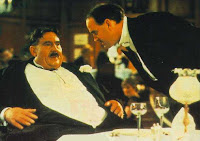Matt Maher sings “Your Grace is enough for me.” But is that enough for God? Is our being saved the end of the story, or do we owe more? Richard Stearns, head of World Vision U.S., tackles this issue in The Hole in our Gospel.
Stearns opens up his book recounting the tale of visiting Richard, a thirteen year old boy in Uganda. Stearns sat in a small hut, listening to a boy who was trying to raise his two brothers alone, their parents having died of AIDS. His mother and father were buried in the ground right next to the doorway; the children passed by the graves constantly. When Stearns asked if Richard had a Bible, the boy ran into the other room and returned, saying “I love to read the Book of John, because it says that Jesus loves the children.”
Only two months before, Stearns had been the CEO of Lennox, makers of those fancy plates. He lived in a ten-bedroom home on five acres outside of Philadelphia. He sat on his church board, ran a multi-million dollar company, drove a Jaguar and flew first class to Tokyo, Paris, etc. Now he was the new head of World Vision, a global, Christian non-profit organization. And he was in an African hut talking to Richard. Word Vision’s founder, Bob Pierce, had said “Let my heart be broken by the things that break the heart of God.” Richard Stearns truly understood these words now.
The crux of this book is Stearns asking the question, “What does God expect of us?” Is being faithful, studying the Bible and going to church enough? “Have we embraced the whole gospel or a gospel with a hole in it?” He then tells his story in the context of the issues that World Vision tackles. The book has lots of statistics and numbers. For example, about 9 million people die every year of hunger or related causes. Every day, 904 children die of an AIDS-related illness, while another 1,150 become infected. Stearns breaks down what some of the overwhelming numbers mean on a more understandable level. He also relates some of his personal experiences since joining World Vision. Be prepared to hear God’s heart breaking.

Stearns greeted God’s call to move to Seattle and run World Vision with about as much enthusiasm as Jonah headed off to Nineveh. He even initially refused the job before realizing that God was guiding him and accepting the call (no whale needed). There is an incredible amount of content in this book that makes Stearns’ call to compassion and justice just plain common sense. Though he’s not a preacher, he knows his Bible and uses verses effectively.
We are saved by Grace: I’m not about to open up the ‘Grace vs. Works’ debate. But during my Catholic upbringing, I learned Ephesians 2:8-10, “For it is by Grace you have been saved through faith – and this is not from yourselves, it is the Gift of God - not by your works, so that no one can boast. For we are God’s handiwork, created in Christ Jesus to do good works, which God prepared in advance for us to do.” Read that last sentence again. Stearns believes (as do I), that we are saved by Grace, but as saved, God expects more from us.
This is reflected in Vineyard Columbus' vision statement, “To be a relevant church that does not exist for itself, but for Christ and the World.” Vineyard didn’t build a Community Center for the membership: it was built for the central Ohio community, to do the work of Christ. The Hole in our Gospel is about being a relevant Christian.
We started with a contemporary worship reference so we’ll close with one, from Casting Crowns’ If We Are the Body:
“If we are the body, why aren’t his arms reaching? Why aren’t his hands healing? Why aren’t his words teaching? And if we are the body, why aren’t his feet going? Why is his love not showing them there is a way?”
Richard Stearns’s arms are reaching and his words are teaching. If you enjoyed reading The Hole in Our Gospel, there is a free, six-week group study guide available for download at World Vision’s website. I was profoundly impacted by this book and recommend it unreservedly.








